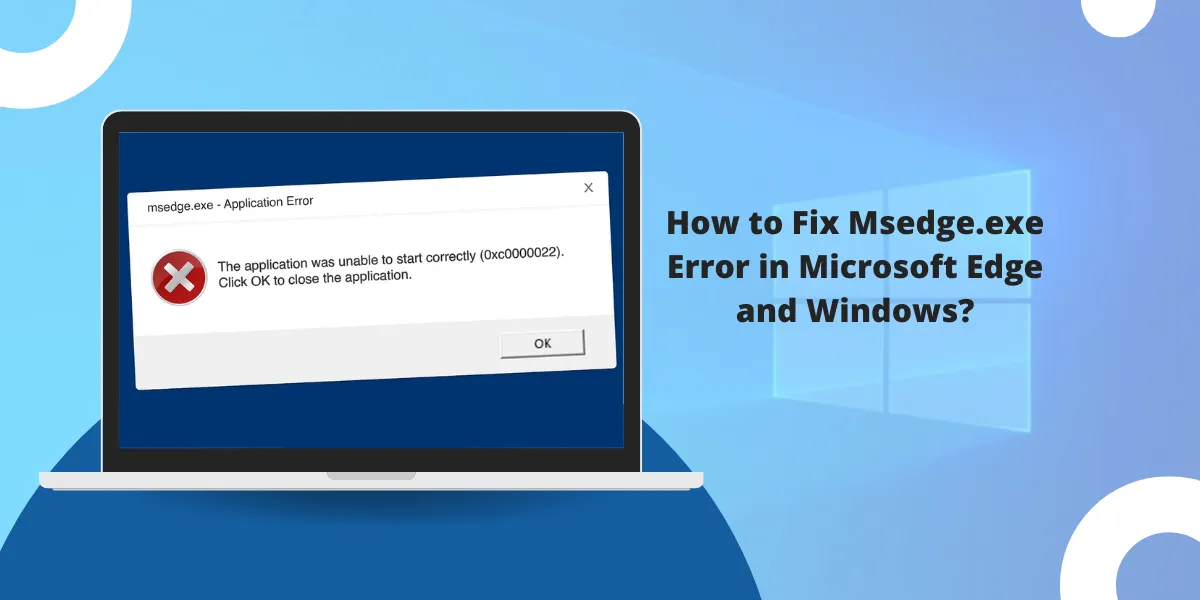What Does Microsoft Edge Msedge.exe Error Mean?
The msedge.exe file is associated with the new Microsoft Edge web browser included with Windows 10 and 11. This process runs in the background to support browser features and operations.
Encountering errors with msedge.exe, such as browser crashes, freezes, or improper opening, can be frustrating. However, by effectively troubleshooting and resolving these issues, you can restore the full functionality of your Microsoft Edge browser.
In this comprehensive guide, we will cover common msedge.exe error messages, diagnose potential causes, and explore solutions to successfully fix msedge.exe problems in Windows 10 and 11.
Key Takeaways
- Msedge.exe is the main process for the new Chromium-based Microsoft Edge browser.
- Common msedge.exe error messages involve crashing, freezing, or failing to launch.
- Potential causes include corrupt files, outdated drivers, malware, and resource conflicts.
- Fixes involve repairing files, updating drivers/Windows, adjusting settings, or removing conflicts.
- Effective troubleshooting uses Event Viewer, Task Manager, Command Prompt, and system restores.
- Reinstalling or resetting Microsoft Edge provides a failsafe fix in persistent cases.
What are the Common Msedge.exe Error Messages
When the msedge.exe file encounters problems in Windows 10 or 11, some common error messages you may see include:
- Microsoft Edge has stopped working: This error indicates the browser has crashed or frozen.
- msedge.exe: System Error: A generic message pointing to an underlying system problem.
- msedge.exe: Application Error: The browser is having trouble launching due to app issues.
- Can’t open Microsoft Edge: Edge fails to open when you try launching it.
- msedge.exe not responding: The program freezes and stops responding to commands.
- msedge.exe: Bad Image: There is a file corruption issue preventing proper execution.
- msedge.exe unable to locate component: A required DLL, file, or resource is missing.
What Causes Msedge.exe Errors?
Msedge.exe errors can arise for a number of reasons on a Windows system. Here are some of the most common potential causes to investigate:
Corrupt System Files
The msedge.exe file itself or associated DLLs and resources may become damaged and cause errors. A partial install, unexpected shutdown during an update, or malware activity can corrupt key browser files.
Outdated or Conflicting Drivers
Incorrect, old, or incompatible drivers for components like video, audio, and networking can disrupt msedge.exe processes. Keeping drivers updated helps avoid conflicts.
Software Conflicts
Other programs on your system utilizing the same libraries or resources as Edge may clash and cause msedge.exe errors. Uninstalling problematic software can resolve this.
Malware or Virus Infection
Viruses, spyware, Trojans, and other malware: especially ones targeting browsers: may modify, replace, or corrupt msedge.exe files leading to problems.
Excessive Resource Usage
Too many memory-intensive programs running simultaneously can overload available resources, preventing msedge.exe from having sufficient RAM and CPU access.
Registry Errors
Corrupted registry files containing configuration data utilized by msedge.exe can cause browser processes to malfunction or crash.
By investigating your specific error symptoms and timeline, you can narrow down the most likely cause(s) behind msedge.exe errors.
11 Easy Steps to Fix Msedge.exe Errors in Windows
Fixing msedge.exe problems require pinpointing and addressing the specific underlying cause. Try these troubleshooting methods to resolve your msedge.exe error issues:
- Restart Your Computer
- Update or Reinstall Drivers
- Scan for Malware
- Use the System File Checker
- Reset Microsoft Edge Browser
- Uninstall Conflicting Programs
- Update Windows
- Clear Browser Cache/Data
- Adjust Resource Usage
- Restore from Earlier System Restore Point
- Reinstall or Reset Microsoft Edge
Step #1 Restart Your Computer
If msedge.exe errors occur randomly or occasionally, try restarting your PC first. This clears out any memory issues or stuck processes that may be disrupting Edge browser operations. The msedge.exe file will reload properly on reboot.
Step #2 Update or Reinstall Drivers
Check for outdated drivers that need updating through Windows Update or your device manufacturer’s website. Video, sound, and network drivers can especially impact msedge.exe.
You can also try uninstalling drivers completely, rebooting, and freshly installing the latest versions. This repairs any corrupted files.
Step #3 Scan for Malware
Download a trusted antivirus program like Malwarebytes or BitDefender and perform a full system scan. Quarantine or delete any malware detected which could be interfering with msedge.exe.
You may need to enter Safe Mode during cleaning to remove persistent threats fully. Repeat scanning to check for residual malware.
Step #4 Use the System File Checker
The System File Checker tool will scan for and replace any corrupted Windows system files impacting msedge.exe:
- Open an admin Command Prompt
- Type “sfc /scannow” and hit Enter
- Restart your computer once finished
This repairs crucial OS resources like DLLs that have become damaged or altered to restore proper functionality.
Step #5 Reset Microsoft Edge Browser
Resetting the Edge browser to factory settings can fix msedge.exe errors stemming from corrupt or outdated configurations.
To reset Edge:
- Open Edge and click the three-dot Menu > Settings
- Scroll down and click “Reset Settings.”
- Choose “Restore settings to default.”
This will wipe browser data and reset msedge.exe processes and settings.
Step #6 Uninstall Conflicting Programs
Check for any other applications like web browsers, video conferencing, or streaming software that may conflict with shared libraries used by Microsoft Edge.
Fully uninstall them through the windows Settings app or Control Panel, then restart your PC to see if msedge.exe errors persist.
Step #7 Update Windows
Make sure your Windows version has all the latest security patches, feature updates, and hotfixes installed.
The Windows Update page in Settings can detect and download any pending updates that may resolve incompatible or buggy msedge.exe file versions.
Step #8 Clear Browser Cache/Data
More-cached data can bog down and overwhelm msedge.exe processes over time.
Open Edge, click the three-dot menu > Settings > Privacy, search, and services. Select “Choose what to clear” and delete Temporary files, cookies, history, and other website/browser data.
Step #9 Adjust Resource Usage
Check if any other intensive programs, such as games, video editors, and development tools, are running simultaneously and monopolizing the CPU, RAM, and GPU resources needed by msedge.exe.
Close unused apps or upgrade your RAM and processors to better accommodate resource demands.
Step #10 Restore from Earlier System Restore Point
If msedge.exe errors appeared after a recent Windows update or configuration change, use System Restore to roll back to an earlier restore point before the issues emerged.
This can fix registry or system file changes that introduced the msedge.exe problem.
Step #11 Reinstall or Reset Microsoft Edge
If no other troubleshooting fixes the msedge.exe errors, fully reinstalling Microsoft Edge will overwrite any corrupted files with clean versions:
- Open Settings > Apps > Apps & features
- Select Microsoft Edge and choose Modify (or Uninstall then reinstall)
- Choose Repair install (preserves data) or Fresh install (erases data)
For a complete refresh, resetting Edge back to default via edge://settings/reset will recompile msedge.exe from scratch.
Using Event Viewer to Diagnose Msedge.exe Errors
Windows Event Viewer provides detailed error logs and warnings that can reveal useful clues to diagnose msedge.exe crashes, freezing, or failures to launch.
To use Event Viewer:
- Type “Event Viewer” in the taskbar search box and launch the app
- Expand Windows Logs > Application
- Look for recent Error events related to Fault Module msedge.exe
- Check the error descriptions and hexadecimal codes
Event Viewer error details can indicate file paths, missing DLLs, registry issues, or specific causes like lack of memory or malformed executables. Use these insights to target your troubleshooting steps.
How to Prevent Msedge.exe Errors in Microsoft Edge and Windows
After fixing current msedge.exe errors, you can take measures to prevent new issues from occurring down the line:
- Keep Microsoft Edge and Windows completely updated
- Don’t ignore or postpone system updates/patches
- Use reputable security software to block malware
- Clean out the browser cache occasionally
- Close intensive programs when using Edge
- Create a periodic system to restore points
- Avoid questionable websites or downloads
Following good security practices, keeping software updated, and maintaining your PC properly will help avoid msedge.exe errors due to file corruption, conflicts, and malware.
Final Thoughts
Msedge.exe errors can cause frustration when Microsoft Edge suddenly crashes, freezes, or fails to open properly. However, troubleshooting the specific root causes: from corrupt files and drivers to resource conflicts: can get the browser back to working smoothly again.
Leveraging Windows tools like System File Checker, Event Viewer, and Task Manager provides powerful diagnostics to identify and resolve issues. Reinstalling Microsoft Edge provides a reliable fallback fix for persistent problems.
Implementing optimization and security best practices will help prevent many common msedge.exe errors in the future. Keeping drivers and Windows fully updated avoids compatibility issues over time. Running anti-malware tools protects critical system files from becoming corrupted.
With the right mix of troubleshooting techniques, remediation steps, and preventative maintenance, you can effectively stop msedge.exe errors in their tracks and maintain Microsoft Edge’s reliable, long-term functionality.
Frequently Asked Questions (FAQ) About Msedge.exe Errors
Why does msedge.exe crash randomly?
Random msedge.exe crashes can stem from corrupted system files, conflicts with other software, malware or viruses, excessive resource strain, or registry problems. Troubleshooting helps identify the specific cause.
How do I fix msedge.exe application error 0xc0000142?
Error code 0xc0000142 indicates a missing or corrupt system file. Use the System File Checker to scan for and replace damaged files. Reinstalling Microsoft Edge may also resolve the issue.
Msedge.exe won’t open: how can I fix it?
If Microsoft Edge doesn’t open, try restarting your PC, updating drivers, resetting Edge to default settings, removing conflicting programs, or running sfc /scannow to repair system files.
What causes the msedge.exe: Bad Image error?
The “Bad Image” error occurs when msedge.exe itself is corrupted. Reinstalling or resetting Edge will overwrite the file. Make sure your antivirus software removes any malware that causes damage.
How do you force close msedge.exe?
Use the Task Manager to force quit msedge.exe. Find the process under the Processes tab, right-click it, and select End task. This will terminate a frozen or unresponsive instance. Then, relaunch Microsoft Edge.
Where are msedge.exe error logs located?
Error logs and details for msedge.exe crashes can be found in the Windows Event Viewer under Windows Logs > Application. Check for Fault Module msedge.exe events.
Does msedge.exe need to run all the time?
Yes, msedge.exe needs to constantly run in the background to handle core functionality for the Microsoft Edge browser, such as rendering web pages. It is a required process.

Priya Mervana
 Verified Web Security Experts
Verified Web Security Experts
Priya Mervana is working at SSLInsights.com as a web security expert with over 10 years of experience writing about encryption, SSL certificates, and online privacy. She aims to make complex security topics easily understandable for everyday internet users.



